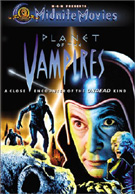Planet of the Vampires (Terrore nello Spazio)
| Mario Bava, who started his career as a cinematographer in the 1940s and began directing films in the early '60s, is generally considered the grandfather of Italian horror. His gaudy, baroque visuals and early forays into disturbing subject matter and graphic violence assured him a spot in the annals of cinematic horror, even if his work wasn't always appreciated while he was alive. While Bava's films often explored similar themes, he branched out early, exploring other genres into which he could infuse his unique sensibility, including the historical epic (Erik the Conqueror, 1961) and fantasy (Hercules in the Haunted World, 1961). His first foray into science fiction was 1965's Planet of the Vampires (Terrore nello Spazio), which played in the U.S. under such titles as Demon Planet and The Haunted World. Shot on an obviously low budget, Planet of the Vampires is nonetheless a creative and sometimes elegant excursion into the blending of science fiction and horror. Although Bava's authorial voice is not as clear as it is in most of his films, his unmistakable stamp is still quite evident in many scenes. Typical of many of Bava's films, Planet of the Vampires was an international production, headlined by veteran American actor Barry Sullivan as Captain Mark Markary, whose space ship is forced by a gravity field to land on a mysterious, fog-enshrouded planet. Once on the planet, the astronauts suspect that they are not alone--something they can't see is trying to control their minds, forcing them to fight amongst themselves and even kill each other. Based on a sci-fi pulp story by Renato Pesteriniero, the narrative constantly teeters on the verge of incoherence (mostly because the characters are so interchangeable and uninteresting that you forget who's who), but it has just enough plot twists and carefully devised revelations to keep you watching. The movie's low budget is quite evident in the more elaborate special-effects sequences. The models are almost embarrassingly evident as such, but Bava achieves an eerie, otherworldly atmosphere in the scenes that take place on the planet's surface, convincingly created on a soundstage. He manages to make the distant planet feel like one giant, gothic haunted house, with craggy rocks and swirling mist and shadows. Bava lit these scenes with his signature array of red, blue, and green lights that make no logical sense, but are great at creating an atmosphere of dread. The cinematography is credited to Antonio Rinaldi, who also shot Bava's Kill Baby Kill (1966) and Danger: Diabolik (1967), but Bava was always fully involved in the visual nature of his films. As he said on more than one occasion, Bava considered himself more of a photographer than a director. Planet of the Vampires is certainly not Bava's best film, either visually or narratively, but it is an interesting, if not entirely successful, attempt at genre blending. The movie sags when Bava's presence can't be felt, especially in the dull opening scenes that take place in the spaceship, with their laughable pseudo-technical jargon and bland exposition. But, once characters start dying and their bloody bodies began walking again, possessed by disembodied, vampiric aliens, Bava is in his element and the movie takes off and never looks back.
Copyright © 2001 James Kendrick | ||||||||||||||||||||||||||||||||||||||||||||||
Overall Rating: 

 (2.5)
(2.5)


